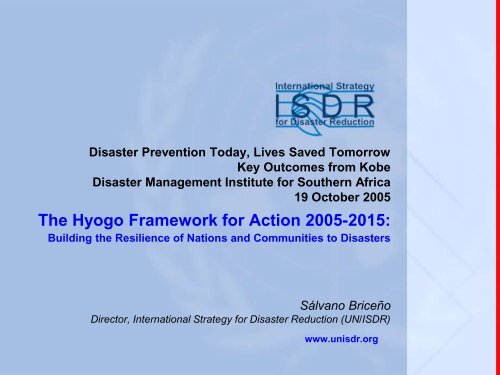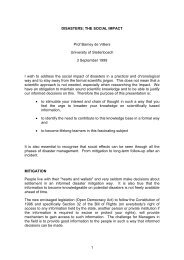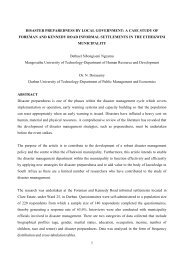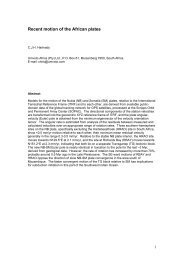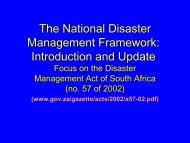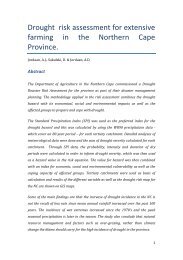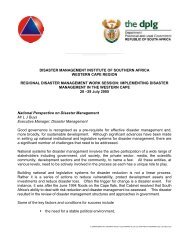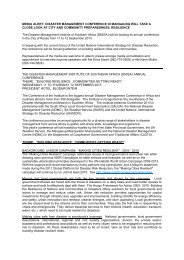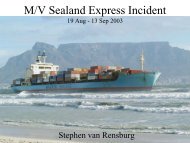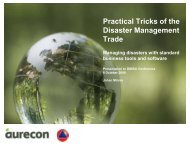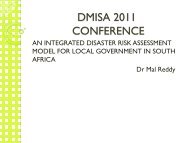Pedro Basabe - The Hyogo Framework for Action 2005 - Disaster ...
Pedro Basabe - The Hyogo Framework for Action 2005 - Disaster ...
Pedro Basabe - The Hyogo Framework for Action 2005 - Disaster ...
- No tags were found...
You also want an ePaper? Increase the reach of your titles
YUMPU automatically turns print PDFs into web optimized ePapers that Google loves.
<strong>Disaster</strong> Prevention Today, Lives Saved Tomorrow<br />
Key Outcomes from Kobe<br />
<strong>Disaster</strong> Management Institute <strong>for</strong> Southern Africa<br />
19 October <strong>2005</strong><br />
<strong>The</strong> <strong>Hyogo</strong> <strong>Framework</strong> <strong>for</strong> <strong>Action</strong> <strong>2005</strong>-2015:<br />
Building the Resilience of Nations and Communities to <strong>Disaster</strong>s<br />
Sálvano Briceño<br />
Director, International Strategy <strong>for</strong> <strong>Disaster</strong> Reduction (UN/ISDR)<br />
www.unisdr.org
Global Trends (risk components)<br />
Natural and human-induced<br />
hazards<br />
Climate change and variables<br />
HAZARDS +<br />
EXTREME EVENTS<br />
Socio-economic: poverty,<br />
unplanned urban growth, lack of<br />
awareness and institutional capacities...<br />
Physical: insufficient land use planning,<br />
housing, infrastructures located in hazard<br />
prone areas...<br />
VULNERABILITY<br />
Environmental degradation<br />
oil spills; coastal, watershed, <strong>for</strong>est,<br />
wetland degradation...
<strong>Disaster</strong> reduction – an agenda in progress<br />
1990s: International Decade <strong>for</strong> Natural <strong>Disaster</strong> Reduction (IDNDR,1990-<br />
1999) – promotion of disaster reduction, technical and scientific development<br />
1994: First World Conference on <strong>Disaster</strong> Reduction: Yokohama Strategy<br />
and Plan of <strong>Action</strong> – mid-term review of IDNDR, first blueprint <strong>for</strong> disaster reduction<br />
policy guidance, social and civil society orientation<br />
2000: International Strategy <strong>for</strong> <strong>Disaster</strong> Reduction (ISDR) - increased<br />
government commitment, linkage to sustainable development, enlarged networking and<br />
partnerships. Institutional mechanisms: IATF/DR, ISDR secretariat, UN Trust Fund <strong>for</strong><br />
<strong>Disaster</strong> Reduction<br />
<strong>2005</strong>: Second World Conference on <strong>Disaster</strong> Reduction (Kobe, <strong>Hyogo</strong>):<br />
<strong>Hyogo</strong> <strong>Framework</strong> <strong>for</strong> <strong>Action</strong> <strong>2005</strong>-2015: Building the Resilience of Nations and<br />
Communities to <strong>Disaster</strong>s:<br />
3 Strategic goals<br />
5 Priorities <strong>for</strong> action<br />
Implementation and follow-up
I S D R<br />
International Strategy<br />
<strong>for</strong> <strong>Disaster</strong> Reduction<br />
International Strategy<br />
<strong>for</strong> <strong>Disaster</strong> Reduction<br />
Launched in 2000 by UN General Assembly<br />
Resolution A/54/219 as successor of the<br />
International Decade on Natural <strong>Disaster</strong> Reduction<br />
–IDNDR, 1990-1999:<br />
<strong>The</strong> ISDR aims at building disaster resilient<br />
communities by promoting increased awareness of<br />
the importance of disaster reduction as an integral<br />
component of sustainable development, with the<br />
goal of reducing human, social, economic and<br />
environmental losses due to natural hazards and<br />
related technological and environmental disasters.
Current ISDR System<br />
1. Inter-Agency Task Force <strong>for</strong> <strong>Disaster</strong> Reduction (IATF/DR)<br />
(2 meetings/year: May and Nov. in Geneva)<br />
2. Inter-Agency Secretariat of the ISDR<br />
• Headquarters in Geneva<br />
• Regional offices (LAC, Africa, Asia, planned in Europe)<br />
• <strong>The</strong>matic Plat<strong>for</strong>ms (CIIFEN, Guayaquil; Global Wildland Fire Network, Freiburg; Plat<strong>for</strong>m<br />
<strong>for</strong> the Promotion of Early Warning, Bonn; International Recovery Plat<strong>for</strong>m, Kobe,)<br />
• Regional Partners and Centres (ADPC, ADRC, SOPAC, CEPREDENAC, CDERA,<br />
CAPRADE, AU/NEPAD, COE, IC/CIS)<br />
• National Committees/Plat<strong>for</strong>ms <strong>for</strong> <strong>Disaster</strong> Risk Reduction<br />
Note: the ISDR system is being discussed among partners and at the UN GA with a view to<br />
enhance and strengthen it to make it an effective instrument to facilitate the implementation<br />
of the <strong>Hyogo</strong> <strong>Framework</strong> <strong>for</strong> <strong>Action</strong>
ISDR Main functions:<br />
(a)<br />
(b)<br />
(c)<br />
(d)<br />
Policy and Coordination: CSD, LDCs,<br />
SIDSs, IPCC, UNFCCC, UNCCD, IEWP,<br />
UN/Water, UN/Oceans...<br />
Advocacy: annual awareness campaign,<br />
educational booklets, other publications…<br />
In<strong>for</strong>mation Management and<br />
Networks: websites, clearinghouse,<br />
library, on-line dialogues, Living with Risk…<br />
Partnerships <strong>for</strong> Applications: with<br />
UN agencies, IGOs, NGOs, Governments,<br />
academic institutions, private sector,<br />
media…
Challenges and shortcomings<br />
<br />
<br />
<br />
<br />
Governments and the public have been slow to<br />
take action on disaster risk reduction<br />
Resources and ef<strong>for</strong>ts go mainly into relief and<br />
recovery, but very little is spent on addressing the<br />
underlying causes of disasters.<br />
Humanitarian action is usually disconnected from<br />
development investments.<br />
Government priorities still reflect this situation
<strong>The</strong> World Conference on <strong>Disaster</strong> Reduction<br />
and <strong>Hyogo</strong> <strong>Framework</strong> <strong>for</strong> <strong>Action</strong> <strong>2005</strong> – 2015<br />
Major review of disasters and disaster reduction ef<strong>for</strong>ts<br />
<strong>Hyogo</strong> <strong>Framework</strong> <strong>for</strong> <strong>Action</strong> – <strong>2005</strong>-2015 - a roadmap<br />
negotiated by Governments<br />
Five priority areas, each with specific actions<br />
A demand <strong>for</strong> systematic, concrete action<br />
Stronger cooperation and international support<br />
encouraged.
Contributing to the achievements of the internationally agreed<br />
development goals (including the MDGs)<br />
International Strategy<br />
I S D R<br />
<strong>for</strong> <strong>Disaster</strong> Reduction<br />
International Strategy <strong>for</strong> <strong>Disaster</strong> Reduction<br />
SUMMARY of the <strong>Hyogo</strong> <strong>Framework</strong> <strong>for</strong> <strong>Action</strong> <strong>2005</strong>-2015:<br />
Building the Resilience of Nations and Communities to <strong>Disaster</strong>s (<strong>Hyogo</strong> <strong>Framework</strong>)<br />
Expected Outcome<br />
<strong>The</strong> substantial reduction of disaster losses, in lives and in the social,<br />
economic and environmental assets of communities and countries<br />
<strong>The</strong> integration of disaster risk reduction into<br />
sustainable development policies and planning<br />
Strategic Goals<br />
Development and strengthening of institutions,<br />
mechanisms and capacities to build resilience to<br />
hazards<br />
<strong>The</strong> systematic incorporation of risk reduction<br />
approaches into the implementation of emergency<br />
preparedness, response and recovery programmes<br />
Priorities <strong>for</strong> <strong>Action</strong><br />
1. Ensure that disaster risk<br />
reduction (DRR) is a national<br />
and a local priority with a<br />
strong institutional basis <strong>for</strong><br />
implementation<br />
2. Identify, assess and monitor<br />
disaster risks and enhance early<br />
warning<br />
3. Use knowledge, innovation<br />
and education to build a culture<br />
of safety and resilience at<br />
all levels<br />
4. Reduce the underlying risk factors<br />
5. Strengthen disaster preparedness<br />
<strong>for</strong> effective response at all levels<br />
Cross Cutting Issues<br />
Multi-hazard approach Gender perspective and cultural diversity Community and volunteers participation Capacity building & technology transfer
<strong>Hyogo</strong> <strong>Framework</strong> <strong>for</strong> <strong>Action</strong> <strong>2005</strong>-2015:<br />
Building the Resilience of Nations and Communities to <strong>Disaster</strong>s<br />
1. Preamble<br />
2. Objectives, expected outcome and strategic goals<br />
- <strong>The</strong> integration of disaster risk reduction into sustainable<br />
development policies and planning.<br />
- <strong>The</strong> development and strengthening of institutions, mechanisms<br />
and capacities to build resilience to hazards.<br />
- <strong>The</strong> systematic incorporation of risk reduction approaches into<br />
the implementation of emergency preparedness, response and<br />
recovery programmes.<br />
3. Priorities <strong>for</strong> action <strong>2005</strong>-2015
Priorities <strong>for</strong> action <strong>2005</strong>-2015:<br />
1. Governance: ensure that disaster risk reduction is a national and<br />
local priority with strong institutional basis <strong>for</strong> implementation<br />
2. Risk identification: identify, assess and monitor disaster risks<br />
and enhance early warning<br />
3. Knowledge: use knowledge, innovation and education to build a<br />
culture of safety and resilience at all levels<br />
4. Reducing the underlying risk factors<br />
5. Strengthen disaster preparedness <strong>for</strong> effective response
Strategic Directions <strong>for</strong> the ISDR System to<br />
Assist the Implementation of <strong>Hyogo</strong><br />
<strong>Framework</strong><br />
1. Institutional commitments: national workshops; guiding principles <strong>for</strong><br />
national plat<strong>for</strong>ms; matrix of commitments and initiatives; regional plat<strong>for</strong>ms,<br />
partnerships<br />
2. Planning and Programming: CCA/UNDAF; PRSPs; mainstreaming in<br />
MDGs; integration into sustainable development and sectors: health, environment,<br />
agriculture, etc.<br />
3. Awareness and Advocacy: awareness raising and educational materials<br />
4. Reporting on Progress and Monitoring: benchmarks and indicators;<br />
reports to UNGA<br />
5. Roles and Modalities of the ISDR System: A widened and re<strong>for</strong>med<br />
IATF/DR; governance mechanism; strengthened Trust Fund; national, regional and<br />
thematic plat<strong>for</strong>ms/networks
Living with Risk :<br />
A global review of disaster reduction initiatives<br />
available on the ISDR website (www.unisdr.org)<br />
Living with Risk is the UN publication which displays in two<br />
volumes the experiences drawn from around the world, on<br />
reducing risk to disasters
Conclusion: A safer future depends on working<br />
together to communicate effectively and motivate<br />
change <strong>for</strong> reducing risk and vulnerability<br />
<strong>Hyogo</strong> provides the <strong>Framework</strong><br />
o<br />
o<br />
Need to engage those aware on a common course<br />
<strong>The</strong>n jointly advocate with those not fully aware as yet<br />
Communicating; exchanging knowledge and expertise; motivating and<br />
facilitating change<br />
o<br />
o<br />
o<br />
o<br />
Working closely with media to in<strong>for</strong>m and motivate the public<br />
Engaging with community leaders to do more of what many already know:<br />
learning from the experience of others<br />
Advocating with policy and decision-makers: in civil protection, environment,<br />
education, health…<br />
Partnering with private sector and academic institutions<br />
o<br />
Bridging policy-professional-community-in<strong>for</strong>mation roles, developing<br />
relationships and strengthening partnerships
" More effective prevention strategies would save not only<br />
tens of billions of dollars, but save tens of thousands of lives.<br />
Funds currently spent on intervention and relief could be<br />
devoted to enhancing equitable and sustainable development<br />
instead, which would further reduce the risk <strong>for</strong> war and<br />
disaster. Building a culture of prevention is not easy. While<br />
the costs of prevention have to be paid in the present, its<br />
benefits lie in a distant future. Moreover, the benefits are not<br />
tangible; they are the disasters that did NOT happen. "<br />
Kofi Annan, “Facing the Humanitarian Challenge:<br />
Towards a Culture of Prevention”, UNGA, A/54/1


